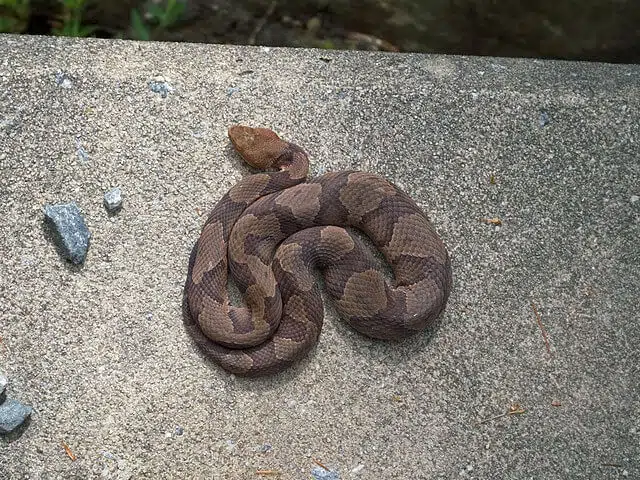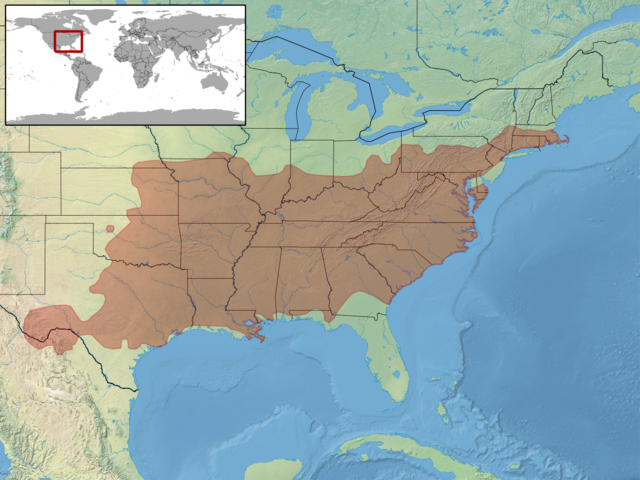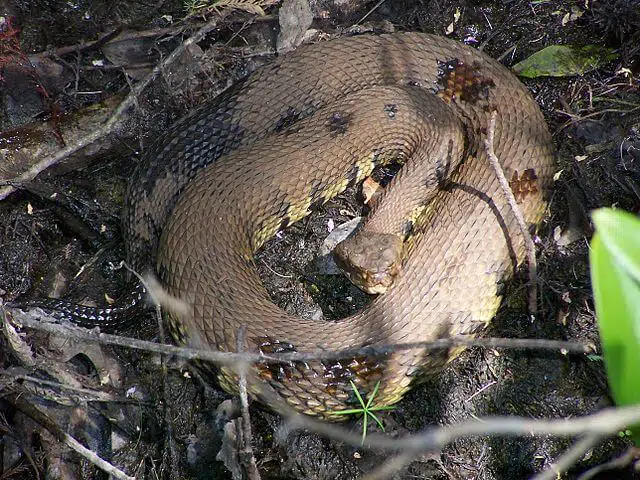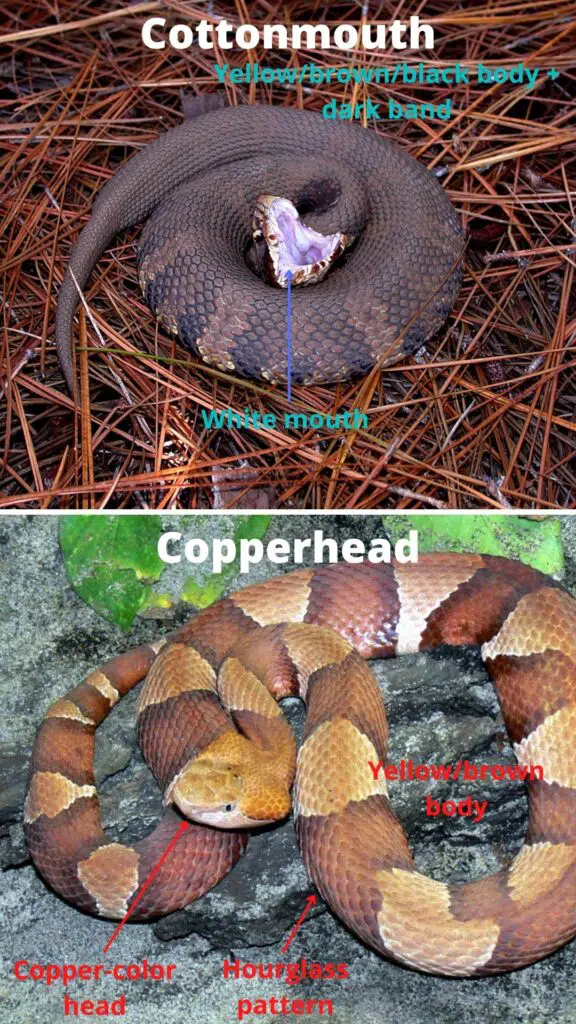Copperhead and Cottonmouth snakes are often confused due to their appearance. However, they are different species with different habits. The Cottonmouth snake has a triangular head shape while the Copperhead snake has a copper-red head that has a different color to its body.
Why is it important to make a clear distinction between the Copperhead and the Cottonmouth snakes?
It turns out these are the most venomous snakes with the highest number of bites in the Southern part of the US every year. The way these bites are medically treated differs. This is why correctly identifying these snakes is crucial.
Whenever you are bitten by a snake it’s best to take a picture of the snake for correct identification of the species at the hospital. In most Southern snakebite cases, this is either the Copperhead or the Cottonmouth.
Table of Contents
What Are Copperhead Snakes?
Copperhead (Agkistrodon contortrix) snake is a carnivore reptile that lives a long life. It’s believed the Copperhead snake lives around 18 years out in the wild. It lives even longer (up to 25 years) in captivity where there’s constant food.

The snake is named after its copper-colored head. Its head is normally colored differently from the rest of its body. While it grows up to a few feet, the snake is first identified by its copper-red color head. Its body is normally of tan coloring with hourglass brown stripes.
These snakes can further be identified by their length. It’s common to see a 2-3 feet Copperhead snake. In extreme cases, the snake can reach a length of 4 feet. Apart from measuring the snake, it can also be identified by the shape of its body, particularly of its tail. Its body narrows towards the end of the tail.
The Copperhead snake creates all types of problems for humans due to its large numbers and due to its widespread habitat, including living in populated areas. The snake is widely popular, especially across Southern US. It doesn’t back down from developed areas either. This combination makes it one of the most dangerous snakes in the country.

However, its venom is rarely fatal to healthy adults. The venom of the Copperhead snake is only truly dangerous for seniors and children.
The Copperhead is a snake that eats mammals. It only hunts warm-blooded prey. This is done through an adaptation of indentations on its head. These are located between the eyes and the nose. The Copperhead snake relies on these indentations to locate its prey even during the night, where many of its favorite prey animals are the most active.
The mating season begins in spring for the Copperhead snake. This is a time of high aggressiveness, particularly for the male Copperhead fighting other males for a chance to mate with the female. The female Copperhead gives birth to live snakes. It’s unclear what determines the number of snakes the female gives birth to but these can be more than 10 at a time.
The snake then disappears underground during the winter and after giving birth to live snakes. It often shares its underground locations with other species during the wintertime.
What Are Cottonmouth Snakes?
Cottonmouth snakes are venomous pit snakes. These are some of the few venomous snakes found in the US. Apart from being venomous, Cottonmouth snakes are also known for being semi-aquatic. This means they are adapted to both terrestrial and aquatic living. They can hunt aquatic prey and terrestrial prey efficiently.

The Cottonmouth snake grows to an adult size anywhere between 2 and 4 feet. These snakes have very thick robust bodies of different colors. Common Cottonmouth colors include brown, black-olive, and even yellow. This coloring makes them similar to other snakes. But they have vertical pupils similar to other mammals which might make identification easier.
Its location might also help establish its identity. Cottonmouth snakes are mostly found in Southern US in states such as Texas and Florida. It’s a nocturnal snake which means it goes out hunting during the night. However, there are plenty of instances when the Cottonmouth snake can be seen during the day. Like other snakes, it prefers to lay in the sun during the day, particularly on hot surfaces such as rocks and pieces of metal.
There’s no favorite prey for Cottonmouth snakes as they tend to eat whatever gets in their way. They eat fish, rats, and even other snakes given the opportunity. Reptiles are also one of the common prey of these snakes as Cottonmouths prefer to live in swamps and similar humid locations where reptiles also grow.
These snakes are highly independent and unlike Copperhead snakes, there’s little data to suggest a given lifespan. Preliminary studies show the Cottonmouth snake lives around 10 years. A part of this uncertainty when it comes to its age is the independent nature of these snakes. Young Cottonmouth snakes wander off by themselves as soon as they are born.
Female Cottonmouth snakes give birth to young live snakes. They normally give birth to as little as 10 snakes and a maximum of 20 snakes.
At the end of the mating season, the Cottonmouth snake goes into hibernation. This is normally a secluded place away from the cold outer weather. The snake prefers burrows made by other animals such as turtles. But you might also find Cottonmouth snakes hibernating under large rocks or other shelter-offering objects.

The snake is generally aggressive to humans even if bites are rare. Cottonmouth snakes have multiple tactics they use before considering biting at times. One of these tactics is shaking their tails. This is assumed to be a mimicking of the Rattlesnake’s behavior. Cottonmouths also open their mouths to look more fearsome in case they feel danger.
Cottonmouth snakes rarely attack humans unprovoked. But they can bite people if handled or stepped on. The bite of the Cottonmouth snake should be taken seriously as it requires immediate medical attention. Venom from these snakes can be fatal to adults. Their venom is believed to cause coagulation issues of the blood. It’s believed up to 10.000 people are bitten by snakes in general per year in the US. Only a few of these bites lead to death.
Why Are Copperheads Often Confused With Cottonmouth Snakes?
These snakes are often confused based on their appearance. Habitat and behavior can also be similar at times.
Location
Both Copperheads and Cottonmouths live in the southeastern United States.
Appearance
Both these snakes grow to a maximum size of between 3 and 4 feet. This is the first characteristic that makes many people wrongly identify these snakes or confuse Copperheads with Cottonmouths.
Habitat
These snakes are both found in certain regions in the Southern US. From Texas to South Virginia, they are seen all over the Southern states. However, this is where their habitat similarities stop as they prefer different terrains and different areas within these Southern states.
Behavior
The behavior of these two snakes is highly different. They are different in aggressiveness and different in how they react to humans. However, they both have unique defense techniques which makes them similar in certain situations when they want to avoid humans. Copperhead snakes are known for faking death.
They remain immobile until humans move along as this is one of their best bets when it comes to dealing with a perceived larger predator. Cottonmouth snakes are known for emitting a foul smell from the musk gland in a similar effort of avoiding a confrontation and deterring humans from getting any closer.
Copperhead vs Cottonmouth: The Differences
| Copperhead | Cottonmouth | |
| Habitat | Rocky mountains, canyons, suburban areas | Marshes, swamps, lakes (near water) |
| Size | Up to 36 inches | Up to 48 inches |
| Lifespan | Around 18 years | Around 10 years |
| Color & Pattern | Yellow/brown body Hourglass pattern | Yellow/brown/black body Dark crossband |
| Head | Copper-color head | Same with the body |
| Mouth | Light red | White |
| Behavior | More aggressive toward humans | Less aggressive toward humans |
| Diet | Lizards, rodents, birds, small snakes | Fish, birds, rodents, small snakes (include copperheads) |
| Bite | Less dangerous | Highly dangerous |
Copperhead and Cottonmouth snakes might have their similarities but there are more differences between these species to know about. From location to lifespan, these snakes are different. They also hunt and live differently.
1. Habitat
Copperhead snakes live in very different habitats to Cottonmouths. You can find Copperhead snakes in rocky areas high in the mountains. They’re also seen in rocky areas in canyons. These snakes are also frequently seen in suburban areas near homes. Hiding under logs and large rocks, these snakes are highly accustomed to living in the proximity of people.
Cottonmouth snakes are semi-aquatic by nature which means they live in completely different habitats. They swim in marshes and swamps the most. These snakes are also terrestrial but they still don’t wander off too much away from water sources where they hunt fish and other animals that live in swamps and habitats next to water sources. These snakes are mostly seen swimming in swamps and lakes. On occasion, they get high up in trees that are next to these water sources.
2. Size
Cottonmouths can grow to a slightly larger size than Copperheads. A Cottonmouth snake can grow up to 48 inches while a Copperhead snake grows up to 36 inches. These are maximum body sizes which are rarely seen in nature as both snakes are a bit shorter in areas where food isn’t highly available.
3. Lifespan
There’s no clear data on the lifespan of these snakes but differences are judged by what we know so far.
Copperhead snakes can live twice as long as Cottonmouth snakes. Copperhead snakes can live up to 20 years although 18 years maximum lifespan is common for most of these snakes. Cottonmouth snakes are believed to live around 10 years.
4. Color And Pattern

The Cottonmouth snake is identified by its brown body with dark crossbands. At times, its body is black with dark crossbands. Some snakes have a dark-yellow body with dark crossbands.
Copperhead snakes are mostly known for having a copper-color head. Their bodies can be read by the hourglass patterns.
5. Head
The main difference in heads is coloring. The Copperhead snake is known for its head that has a different color than its body. As its name suggests, Copperhead snakes have a copper-color head, unlike Cottonmouth snakes that have the same color both on the body and on the head.
6. Mouth
The color of the mouth is one of the distinct characteristics of these snakes. Cottonmouth snakes have a white mouth which also gives the snakes their name. This white mouth is best seen when the snake prepares for an attack opening its wide mouth.
7. Behavior
The way these snakes act is also very different. While these species aren’t particularly known for aggressive behavior towards humans, the Cottonhead snake is known for generally being more aggressive. Cottonmouth snakes prefer to flee when seeing humans.
On the other hand, these snakes can become highly aggressive between them in the mating period. Male Copperhead and male Cottonmouth snakes become even more aggressive towards each other when it comes to attracting a female mating partner.
The hunting technique differs in these snakes. Cottonmouth snakes chase prey or wait for it, depending on the situation. The excellent camouflage abilities of the Cottonmouth allow it to sit and hide waiting for the prey to come close.
Copperhead snakes use their ability to identify warm-blooded animals. They bite small animals and hold them in their mouths until they die and they soon swallow them. When hunting larger animals the Copperhead attacks once by biting and injecting venom. It then follows the animal until it dies.
8. Diet
All types of animals are considered by the Cottonmouth snake. It eats plenty of fish and lizards as it’s a semi-aquatic snake. But it also eats birds and rodents.
Copperhead snakes eat lizards, rodents, and some types of birds that are small enough for them to swallow. From these two species of snakes, it’s the Cottonmouth that eats more types of animals even eating dead animals.
The two snakes eat all types of animals. Cottonmouth snakes are some of the most avid eaters in the snake world as they aren’t too fussy about their next prey. They look at species of fish, birds, and rodents as a good meal. Cottonmouth snakes are also known to eat dead animals they find in nature. They can eat a part of a large dead animal when encountering larger dead animals. These snakes are also known to shed their skin a few times per year.
Cottonmouth snakes tend to eat a lot which also means they shed their skin multiple times per year as this process is tied to the amount of food they eat. Copperhead snakes are a bit pickier about their foods. They even use a patient tactic of wiggling their tails to attract food. This luring method is not something the more aggressive Copperhead snake is known for.
9. Reproduction
Cottonmouth snakes breed in the spring and then again in the fall.
Copperhead snakes also mate in a similar period. But Copperhead male snakes are more aggressive towards each other fighting between them and trying to impress females with their power.
Young Cottonmouth snakes remain with the female until they grow while young Copperhead snakes can wander off on their own sooner.
10. Bite
The venom of these snakes is dangerous but on different levels. The venom of the Cottonmouth snake is considered highly dangerous and potentially fatal for adults. The venom of the Copperhead might only be fatal for children but in rare cases.
Bite symptoms tend to be different as well. They appear in minutes or hours after the bite for both snakes.
The bite of the Copperhead comes with severe pain, skin bruising, and even trouble to breathe. Other symptoms include the change of tastes in the mouth as you might feel a metallic taste on the tongue soon after the bite.
Bite symptoms of the Cottonmouth are very similar but the way the skin looks in the area of the bite is different. There’s noticeable skin discoloration in the area of a Cottonmouth bite on the skin. The skin bruises when bitten by the Copperhead snake. Otherwise, symptoms such as pain and difficulty breathing are highly common following a Cottonmouth snake bite.
Cottonmouth venom is considered very toxic as opposed to the non-toxic venom of the Copperhead.
The red blood cells are destroyed by the venom of the Cottonmouth snake, essentially killing the bitten creature or person. The bite of the Copperhead snake is not as dangerous or fatal. It mostly results in temporary skin and muscle damage in the area of the bite but death is rare following its bite.
Summary
Both Copperhead and Cottonmouth snakes are similar but yet different types of snakes. Studies show these two snakes are often confused. One study found almost 40% of Copperhead snakes are wrongly identified as they’re young Cottonmouth snakes.
Otherwise, these snakes live different lives and most of their resembles are physical (except the head) and in aggressiveness towards males of the species during the mating period.
While venomous, deaths following the bites of these two snakes are rare. There are only a handful of deaths from snake bites reported in the US each year. Death is most likely to happen following a Cottonmouth snake bite in most cases.